Nothing beats unstructured outdoor play for improving handwriting skills.
However, there are a lot of other simple changes you can make in your child’s daily routine and indoor environment to promote the development of fine motor skills.
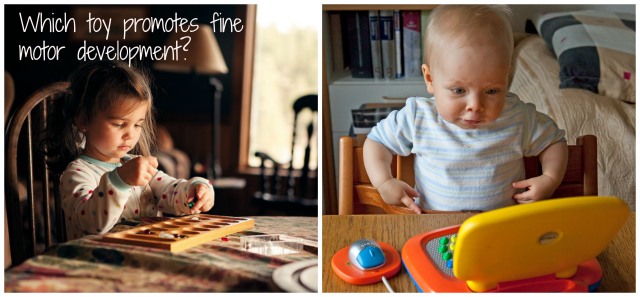
Toys and day to day life at home used to provide lots opportunities for children’s fine motor growth. But suddenly we are seeing a large number of children who are lacking adequate core, upper body and finger strength and dexterity to successfully pick up a pencil and write with ease.
Has home life really changed that much in the last 25 years to affect children’s fine motor development?
The transformation of children’s toys
If you really begin to examine the toys marketed to children today, you will notice a huge change has taken place.
Essentially, we’ve replaced toys that involved a lot of loose parts and manipulating with your hands with ones that require just a push of a button to make a sound or light up.
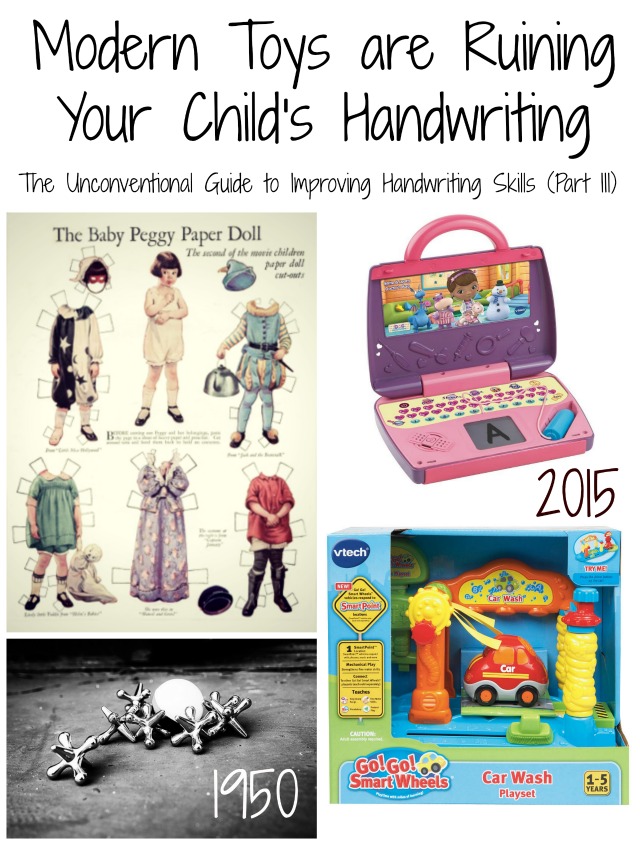
We have a ball in our house – given to us by a well-meaning family member – that rolls itself, makes animal noises when you press the creepy looking cartoon dog or cat and then yells at you when you stop interacting with it!
With a degree in Early Childhood Education, I’ve always been very adamant about the types of toys we have in our house for our daughter. I’ve always been against battery operated toys for the reason that they don’t require kids to problem solve, think creatively or use their imaginations.
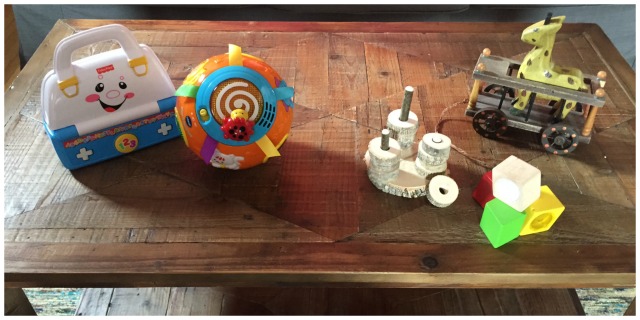
After speaking to some experts in pediatric occupational therapy, I learned that these modern electronic toys also deprive our children from practicing the necessary skills for fine motor and handwriting.
While of course toys are meant to entertain, the purpose of play in early childhood is to manipulate objects, perform experiments and examine the world in order to learn. While many toys today may keep a child busy, they may be doing nothing to actually enhance their development.
Rachel Coley, OT and founder of CanDo Kiddo, really enlightened me when I asked her if anything has changed in the last 25 years in regards to kids’ activities that develop fine motor skills.
Through the materials and toys we choose for our kids and the way they spend their time…
We over-emphasize the skills of pushing buttons with their thumbs and pointing, dragging and clicking with their index fingers.
Because there aren’t any more hours in the day than there use to be, these activities come at the expense of our kids learning to cut, glue, pinch, put together, pull apart, squeeze, twist, hammer and screw, lace, string and other important fine motor skills.
Think about the toys you played with as a child, or better yet your parents or grandparents.
Modern Convenience = Lazy Fingers
Just as life as gotten easier for mom with Click Connect car seats & strollers and Bumbo chairs at the expense of our babies’ gross motor skills development, modern convenience has also stripped our children of everyday fine motor skills practice.
We’ve made childhood really convenient and easy with velcro and slip on shoes, food that can be slurped from pouches and zippered lunch boxes. – Rachel Coley, OT, CanDo Kiddo
In addition, in our busy society we often do things for our children that they should be learning to do on their own.
I admit sometimes I am in a rush to get my daughter out the door and do a lot of things for her I shouldn’t like spoon her peas into her mouth (it’s faster and less mess) and avoid real cups (sippy cups don’t leave you bathed in milk).
However, when you aren’t pressed for time, slow down and let your kids try things on their own.
My daughter is very strong-willed so she often chooses to do things on her own even when I want to help – hence this adorable fiasco when she lost her shoe outside:
While this attempt was ultimately unsuccessful…
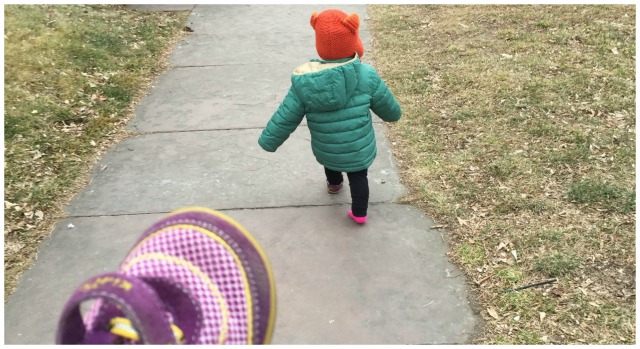
She has since improved since I let her have lots of practice – just not when we’re on a strict time table.
What are fine motor skills? Why are they so important?
Writing expectations for early elementary students have increased significantly over the last couple of decades. Some kindergartners have writing workshop for as long as an hour every day!
At the same time we are introducing more academic demands on children, we are replacing the activities and tools that naturally promote the development of fine motor skills.
Just understanding what fine motor skills are enables adults to seek out and promote experiences for children that will help develop these important muscles and skills.
The great news is that you don’t need to learn and prep a lot of fancy activities. Just by understanding the basics of fine motor skills, you can prioritize the materials in your house or classroom to facilitate this development in your kids.
Understanding the pincer grasp
The pincer grasp is the ability to pick up small objects using the thumb and forefinger. This develops by age one (and continues to mature) as babies move from a raking grasp with all fingers to picking up individual cheerios with just these two fingers.
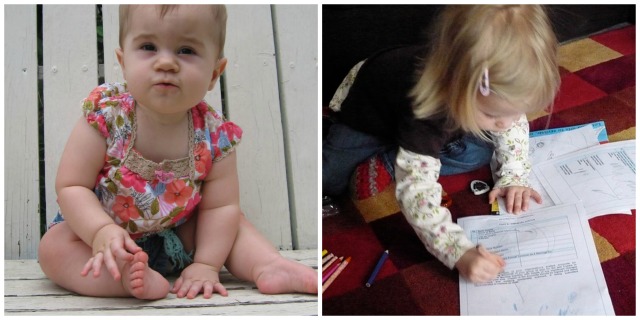
The pincer grasp is very important in handwriting. It enables children to hold a pencil correctly and develop a mature tripod grip around a pencil.
Seems simple, so why is it so important?
Children with nonfunctional pencil grips will not be able to keep up with the demand expected of them in school. They will begin to avoid writing tasks and their academics and confidence will suffer.
Here is what the development of a child’s pencil grip looks like:
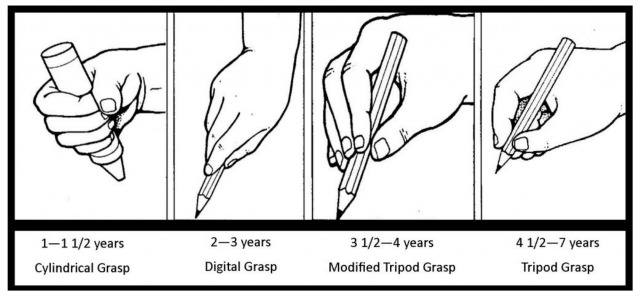
The importance of hand and arm muscles
Writing uses a lot of different muscles in the hand and wrist. In addition to developing a good pincer grasp, children need to make sure their hand and arm muscles are also strong.
Christie Kiley is a pediatric OT experienced in early intervention (birth to 3), clinic-based and school-based settings who runs the blog Mama OT.
While I knew that developing hand strength was important in improving handwriting skills, Christie explained to me just how complex and important these hand muscles are.
There are all sorts of small muscles in our hands that make up three main arches around our hands.
These arches work together to help our hands accurately form around objects as we hold and manipulate them, such as when we hold a ball, build with blocks, or brush our teeth or hair.
These palmar arches are also responsible for helping kids develop in-hand manipulation skills and dissociation of the two sides of the hand.
In order to properly develop these arches, Christie advocates for weight bearing activities on kids’ hands such as crawling through tunnels, doing crab walks down the hallway, yoga (downward dog) and gymnastics (handstands).

Strategies to improve handwriting skills
Just by editing a few things in your daily routine and having certain materials and toys on hand, you can help your child develop the necessary fine motor skills to improve handwriting.
The biggest things that parents can do to promote their kids’ fine motor skills is to evaluate the toys and materials in their homes and evaluate their family schedule.
Many parents are surprised to find that Occupational Therapists don’t have much specialized equipment for treating their children’s fine motor delays or handwriting difficulties.
What we have are toys and time being fully present with a child. – Rachel Coley, OT
Here are 5 tips for improving handwriting skills in your own home or classroom with lots of ideas for simple toys and materials to stock your house with!
1. Give time for independence in daily routines
It’s so easy today in our hectic lives to do things for our children that they could be learning to do themselves. Whether we don’t schedule in the time or are afraid of the mess – I’m guilty of both – encouraging your child’s independence has huge rewards.
Meal times, grooming and getting dressed are great opportunities to let kids take charge and strengthen those little hands and fingers!

During meal times kids should be working towards independence with:
- peeling fruit (oranges, bananas)
- pouring drinks
- using knives to cut food
- using knives to spread butter (or jam, cream cheese, PB) on bread
- opening & closing lunch containers, snack bags and water bottles
With babies, move beyond just purees and encourage self-feeding from the start. Toddlers should be using forks and spoons on their own and drinking from real cups.
After being inspired by Christie’s advice, Reagan successfully peeled her own clementine:

Toddlers definitely still need some help getting dressed but older children should be doing this independently with just a little support and adult encouragement.
While you may need to help out after to make sure the job is done thoroughly – have children participate in their own grooming.
Kids can:
- put on & take off socks and shoes
- do zippers, snaps and buttons
- learn to tie their shoes
- brush their hair
- squeeze their toothpaste
- begin to learn to floss
2. Help out around the house

Most moms know that having young kids at home – especially if they aren’t in school yet – makes it 10 times harder to get anything done around the house.
However, you can provide kids with lots of great fine motor experiences by having them help you out around the house.
Kids can help tear lettuce for salads, mash avocados for guacamole, grate cheese, scrub potatoes, mix thick batters and knead & roll dough when you’re working in the kitchen.
Last time my husband made a smoothie, my daughter help by separating the cilantro leaves from the stem – of course she threw the leaves in the sink and the stems in the blender, but she had a great time helping out!
While doing laundry, kids can help pull clothes out of the hamper, washer and dryer. The youngest kids can fold socks while older children can help with shirts and pants.
3. Buy the right toys
While most parents despise talking toys, now we have some real reasons to replace them in our homes – your child’s fine motor skills, handwriting and success in school depend on it.
Here are some simple guidelines to purchasing toys to promote fine motor skills:
- Avoid anything with batteries
- if it lights up, moves on its own or makes noise count it out
- Stick with natural materials
- it’s much harder to go wrong with toys made out of wood
- Look for toys with “loose parts”
- check Etsy or DIY – sometimes the best toys are not really “toys”
- Look to Reggio Emilia and Montessori schools for inspiration
Need some more ideas? Here are some examples of great toys to buy:
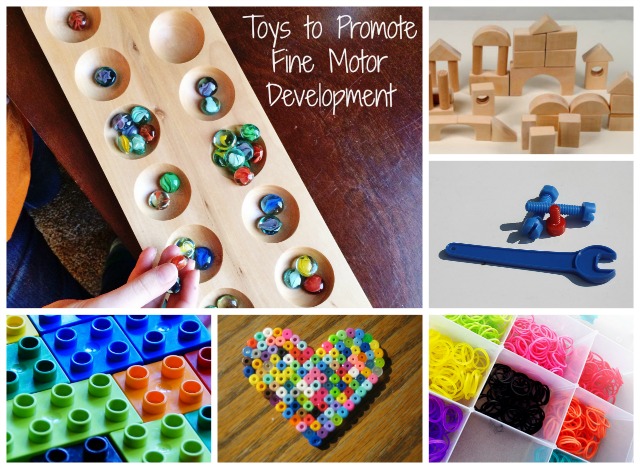
- Mancala
- Traditional wooden blocks
- Legos – opt for loose blocks and not themed sets
- Guidecraft construction blocks
- Tool sets
- Pegboards – buy one from Etsy, Amazon or DIY
- Geoboards – buy from Etsy, Amazon or DIY
- Build & paint car kits
- Rainbow Loom
- Perler beads
4. Make use of everyday objects
Sometimes the best toys are not even meant to be toys! Consider having these available for play:
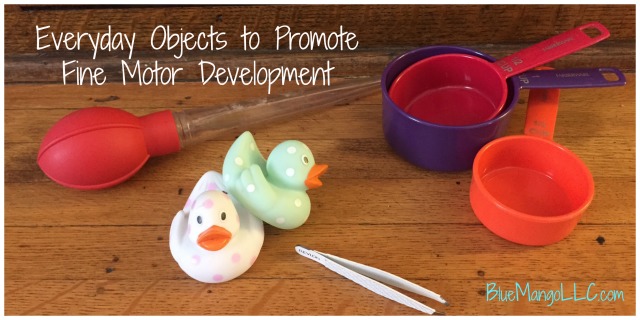
- cardboard boxes – need ideas? follow my Pinterest board!
- tweezers
- chopsticks
- turkey basters
- squeezable bath toys
- scoops & measuring cups
- medicine droppers
- squirt bottles
- chip clips
- buttons, dried beans & dried rice
Christie Kiley often tells parents of children receiving OT services that there are lots of ways to provide the same type of therapeutic practice in their own homes:
Some examples include pinching toothpicks and dropping them into an empty spice container, squeezing chip clips onto the edge of a box, playing with a squirt bottle, and pushing pipe cleaners into the holes of a colander.
5. Have great arts & crafts materials on hand
I always loved stocking up the art center in my classroom at school – often we called it the “Creation Station” because it was so much more than just drawing or painting.
Promote fine motor skills by encouraging kids to make art or create inventions by cutting & pasting, threading & beading, working with small objects and building with clay or cardboard.
Here are some great materials to have on hand at home or in the classroom.
Build

I probably spent most of my childhood constructing things (mostly houses) out of cardboard boxes. Not a surprise I studied architecture in undergrad. I also have a deep appreciation for the hand muscles involved in cutting corrugated cardboard with scissors.
- recycled cardboard boxes
- recycled plastic containers & bottles
- glue
- masking tape
Sculpt
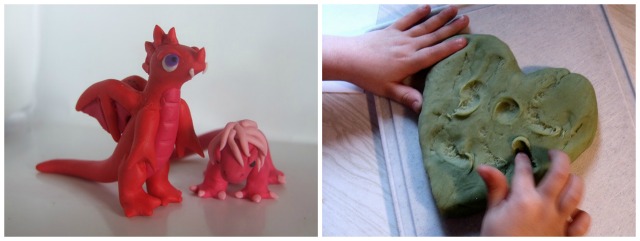
Some of my favorite ways to spice up play dough are to add tools like knives and plastic scissors. I also hide plastic jewels inside play dough to let kids find them as a quiet time or stress relieving activity.
Use any of these materials to help build letters or sight words in the classroom.
- clay
- play dough (make your own!)
- Wikki Stix
Sew & make jewelry
Don’t be fooled – boys love this too! In my class we always made “pattern bracelets” with beads and pipe cleaners as a math center. We also made necklaces with fruit loops (arrange by color in groups of 10s) for the 100th day of school.

Sewing can be just putting yarn through punched holes in construction paper to actually sewing real things. Don’t just make beaded necklaces but teach kids how to braid friendship bracelets.
- plastic needles (real ones for older kids!)
- thread, yarn, string
- wire
- pipe cleaners
- beads, noodles
Cut, paste & fasten
Don’t forget about traditional arts & crafts materials. These are always handy to have around.

- scissors
- hole puncher
- glue, glue sticks or paste (all use different muscles)
- scotch tape, colored masking tape
- paper with assorted thickness (tissue, construction, card stock)
- fabric squares
- brads (brass fasteners)
- stamps & ink
Also consider including small objects that really require the pincer grasp for kids to add to their art work:

- buttons
- pom poms
- jewels
- stickers
- toothpicks
Use your whole body
In addition, any activity done in a standing or prone position will also help with overall core and upper body strength. Use sidewalk chalk outside, have clipboard available for work on the floor and use easels for drawing and painting.
What will you implement today?
Although a lot has changed with children’s toys and play over the last few decades, the great news is that with a few small changes you can easily bring back fine motor development into your children’s day.
Make thoughtful toy purchases and take advantage of everyday fine motor activities such as buttoning a jacket or kneading pizza dough.
Just by understanding the importance of the hand muscles and pincer grasp, you will be able to evaluate toys and materials on your own and come up some great activities.
Want to share this information with parents and friends? Download the FREE printable PDF Tips to Improve Fine Motor Skills today by clicking here!
Please share your creative fine motor activities!
- Has this post inspired you to change anything at home? About the way you teach?
- What activities do your kids or students love?
- Have you found any strategies that work really well?
Start the discussion by leaving a comment!
Image credit: This post wouldn’t have been possible without all the gorgeous images. Many thanks to… Gerwin Sturm, Janet, Steven Depolo, lisaclarke, Daniela, Hsien-Hsien Lei, Gina Lee Kim, davidd, photographer pandora, Andrea R., Lars Ploughman, Matt Preston, Pearlmatic, Ville Oksanen, Travis Swan, Angie Six, Dana, Christine McIntosh, John Parrish, Shannon, Diana Robinson
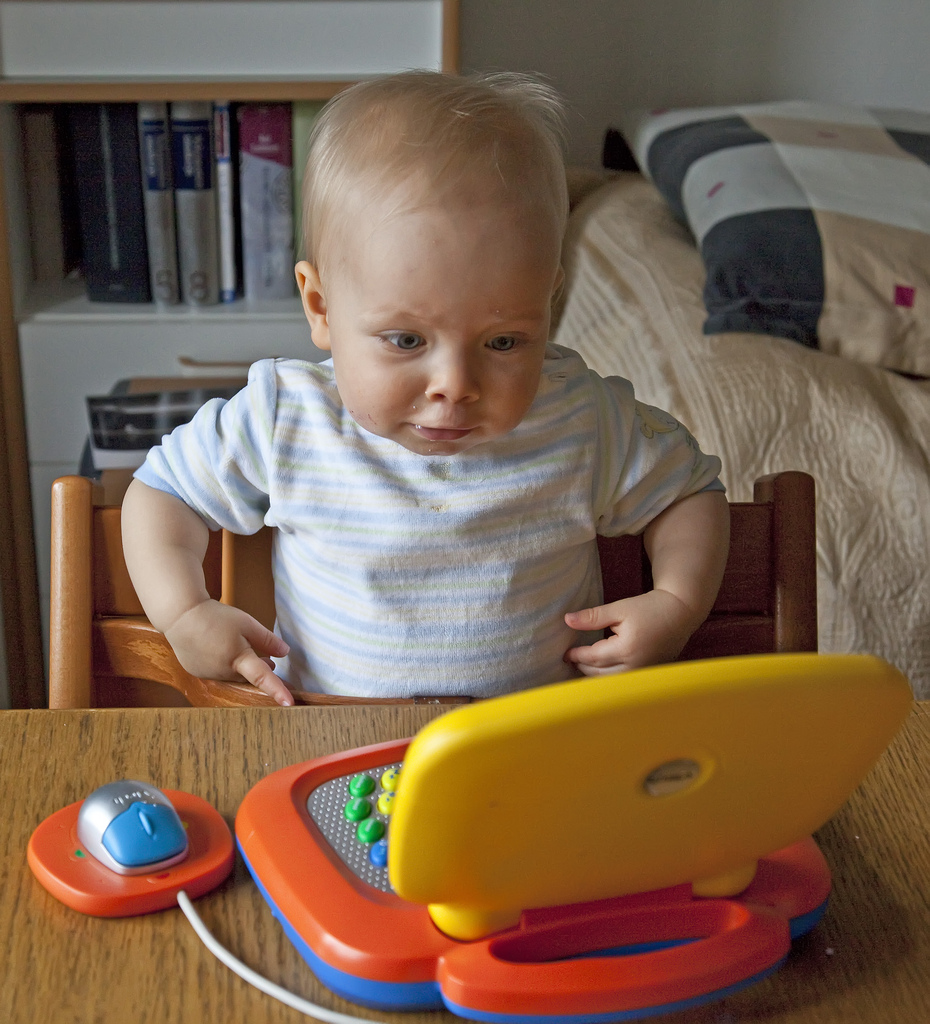
great article. I have been an elementary art teacher for 35 years. I see this everyday, it hurts to color! Some children have never used a pair of scissors by the first grade. It is not that they can’t colr, cut or paint when they are instructed, but they say it is so hard and they can’t complete projects because it hurts, they have not developed the fine muscles needed. Also, special relationships are so poor. Children often can’t put paper on my drying shelf. It is so weird to see a child keep jamming and wrinkling a paper trying to fit it into a shelf, all they have to do is to turn the paper so that the short end goes in first, but they keep shoving until I go and show them how. That just started to happen in the last couple of years. I am saddened by how little fine motor skills so many children have acquired by the time they get into school. They never do crafts or fun activities in the regular classroom either, the work on computers and take tests. Creativity is disappearing at a time the world will need new ideas.
I know exactly what you’re talking about Jane and it’s so sad to hear!
This is a lovely article! I wish it was printable so I could give it to the parents of my EI toddlers. One of the first things I do when I start direct service with a baby or toddler is offer suggestions on toys or if the family can’t afford them I give them toys I’ve bought at thrift shops, such as sets of blocks, duploes, wooden puzzles, old style busy boxes, etc. I also bring lots of bags of “junk” such as buttons, checkers, dominoes, egg cartons, toothpicks, foam trays, pipecleaners, etc. to work on the early fine motor skills. Right now I am seeing two babies who for various reasons can’t eat solids yet, so they don’t get a chance to finger feed. I’ve been working with the parents to work on developing a pincer grasp with some of the items above. I also guide them gently away from the battery operated toys and suggest that the more a toy does for the child, the less the child learns from it. All (or most) of the parents I work with or do evaluations for are very appreciative of the suggestions and tend to “get it” when I explain how important these skills are. Thanks again for the article!
Thanks Marianne! You’ve inspired me to make some printable downloads for specialists to share with parents – they’ll be in Blue Mango’s free resources soon! Keep up the great work with your little ones!
Wonderful! I am a Pre-K teacher as well, so you don’t have to sell me. I am going to share with the director of our school, because I am sure she will want to send your article to the parents. Thank you!
Thanks for spreading the word Heather!
Great article – just an observation: obviously we need to be aware of choking hazards, so another reason to be fully present to children when they play with some of the smaller objects.
Great reminder Anne! I recently saw my daughter stuffing some mini elephants in her mouth and had to remind myself she is still only a toddler. Any small parts used for older kids should be kept out of reach and thoroughly cleaned up around younger siblings.
Let kids sit inside one of those hard plastic swimming pools (without water) and give them things to tear up (literally) — old phone books or catalogs, paper of different thicknesses, magazines, etc. You can have older kids take a magazine and look for a certain thing to tear out, such as pictures of flowers or of babies. And all the scraps are contained inside the pool for easy clean up. You can also have them cut things out or use hole punches. And it is a great way to have a contained area for play-doh fun, and as kids can create with the play-doh as well as press play-doh onto the raised images of the pool itself to make designs.
A second idea is to clean empty plastic bottles (like ketchup bottles, for example) and let kids squeeze them to make air come out of the opening. They can have races trying to propel a cotton ball across the floor without it touching the bottle, just by blowing it with air from squeezing the bottle.
Fantastic ideas! Thanks Ellen!
This article is wonderful! We see these issues everyday when working with the teachers and parents who use our products. There is such a deterioration in fine motor skills for so many reasons.
What are your thoughts of the impact of touchscreen technology use in preschoolers? We feel that the rise of pre-schoolers spending more time using touchscreens is also having a dramatic impact on these issues.
Thank you for writing a great piece and doing great work. We’ve shared on our page and would love to talk to you if interested about contributing to our blog!
Best Wishes,
April Whitlock
CEO, Fundanoodle
http://www.fundanoodle.com
I would love to contribute to your blog April! I’ll be in touch!
I think things like iPads can be used purposefully in limited amounts with preschoolers but I don’t think it’s necessary. Using an app for a few minutes a day to work on a very specific skill – as I designed Ollie’s Handwriting & Phonics to be – is much different than playing a mindless, addictive game.
I know some parents who have used Daniel Tiger to help with the concepts of sharing and potty training and that seems to work well for them. However, I do feel a lot of schools just have iPads to say they have iPads but aren’t using them constructively with children.
Unless working on a very specific skill – and sometimes the best way to access material for students with special needs – I think it’s unnecessary in most preschool settings. It can take away from more important tasks and most children have plenty of exposure to screen time at home.
By elementary school there are a lot more advanced, creative things students can do with iPads. You can check out my screen time post here: http://www.bluemangollc.com/screen-time/
Love this. As the mom of two boys and former kindergarten teacher, I’m always looking for fun gifts to help with motor skills. A favorite birthday gift we used to give was a school box filled with sticky notes, scissors, tape, a small stapler and staples, markers, crayons, etc. Always a hit !
Another fun activity for motor skills – have the child put a penny in a ball of clay. Using only one hand, they have to work the penny back out of the clay. Try it using each hand. Really helps strengthen their hand motions.
Such great ideas Terry! I may steal the birthday gift idea when my daughter gets older. I dread when people buy my daughter gifts because it’s always the latest push button toy!
My son loves anything with a locking/hardware type mechanism. When he was 1, he would spend a long time just removing and reinserting keys from locks (filing cabinets, jewelry boxes), etc. When he turned 2, we got a variety of hinge type locks that you can find in the hardware department of any home improvement store. They require some tinkering to lock/unlock, and some require hand muscle strength, but he has learned to do all of them well. Some of his favorite “toys” aren’t really “toys” at all! But aren’t they?
Wonderful toys! I love it Katie!
I love this article I to am an educator and have many discussions with family and friends about what I do and don’t want for my 10 month old son but I still receive toys I do not want because of the reasons you have stated. I think to I am always talking to my studenets parents about these issues as they are very important in the education systems we are now implementing. I will be passing your articles on. And although I get judged all the tim e back to old school play and discovery I say! 🙂
Thanks Mialanda for passing this important information on! I think I need to share with my family so they really understand why I am so high-maintenance about gifts 🙂
Wow what a great article! There was so much great information and tips in here. I am a pediatric OT an I am always suggesting toys without batteries. I don’t know how many times I pull out a toy and there parents say ” I remember that from when I was little. I use to love that” then I always comment about how it’s still around because it’s super important for development. I always am telling parent that while the iPad has “fine motor” games it’s just not the same a getting you hands on real toys. Thanks again I really enjoyed this.
Thanks Jennifer! An iPad can help with lots of skills but won’t give kids the strengthening and pincer grasp work that they need. Thanks for promoting old fashioned toys without batteries!
Such a great article! We do a lot of slowing down to show our toddler how to participate in daily routines and eventually become independent. Amazing to witness the growth in self-confidence and joy! She loves to cut up fruit, wash the windows, and do laundry. The benefits of carefully selected toys have a huge impact on brain development as well as motor skill development. One boy in my preschool demonstrated quite weak fine motor skills and concentration and his parents listed iPad and large trucks as his main play toys. I will be sharing this article with more people. I love all the suggestions you have. And I also really like your pictures of the progression of pencil grasp. I’ve noticed my daughter has a strong digital grasp and I couldn’t find a good picture to indicate what to look for next, and also ensure that it is age appropriate. Thank you!
Thanks Carrie! What great activities you are doing with your toddler. That’s a great point that carefully selected toys are also important for brain development as well as fine motor skills. It’s so fun to watch the development of the pencil grasp and writing skills isn’t it?Keep spreading the word!
I use bubble wrap to develop the muscles needed for handwriting. The kids love to pinch and pop the bubbles. The small bubbles work best for this activity.
Great idea! Everyone loves bubble wrap.
Thanks so much for this printable. I saerttd using HWT with my 5 year old this summer and his attitude toward writing has made a complete 180! Between the stamps and chalk, he’s never board! This printable will really help! Darci
Could you direct me to where you found that excellent developmental grip photo? I am writing an academic paper relating the development of pencil grips to the development of piano finger posture (they both face similar challenges when it comes to strain and collapsing knuckles), and would like to be able to reference this.
Hi Anna,
This image was given to me by a pediatric occupational therapist. If you do a google search you might be able to find more information about it! See here http://bit.ly/1MGSVcz
As a retired nursery head teacher I am now enjoying setting up a playroom for my granddaughter who is coming to stay for 6 months. One of the favourite threading activities my school pupils enjoyed was making necklaces. Jumbo drinking straws cut into short lengths and loose weave material cut into small squares can be threaded alternatively onto wool with thick blunt crewel needles. Fine motor skills and mathematical one to one correspondence practice in one fun activity